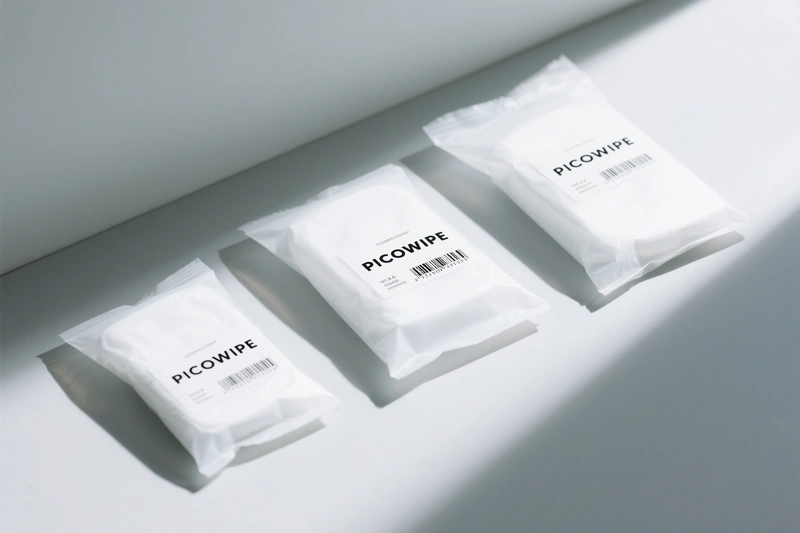By [email protected] — Charting the depths of expertise
This article provides a comprehensive analysis of the performance differences between knitted and woven fabric structures in cleanroom wipe applications. The core conclusion is: the fundamental structural differences determine their respective strengths and weaknesses. Neither is absolutely better; the optimal choice depends on the specific application. In practice, the vast majority of cleanroom wipes feature a double-knitted structure.
I. Core Structural Differences: Knit vs. Woven
Structural differences between knitted and woven cleanroom wipes:
Knitted:
Structure: Similar to knitting a sweater, it's formed by a single yarn bent into interlocking loops. This structure gives the fabric a natural elasticity, like countless tiny springs. Elasticity: When stretched horizontally or vertically, one direction will have noticeable elasticity, while the other will have only slight give. This elasticity becomes less apparent in fabrics with a higher basis weight (thicker and denser). You can easily tell if a wipe is knitted by giving it a gentle pull. Patterns: Divided into rib knit and interlock knit. Woven:
Structure: Formed by two sets of yarns, the warp and weft, interlaced at a 90-degree angle. The yarns are straight, creating a stable structure. Elasticity: Almost no elasticity. When pulled horizontally or vertically, it feels firm and does not stretch. Patterns: Divided into plain weave, twill weave, and random weave. (Satin weave also exists but is not used for cleanroom wipes).
The elasticity described above is primarily an addition to the yarn's base properties. Note that the yarn itself may have slight elasticity from texturizing processes. However, even with texturizing, this elasticity is far less than that provided by the fabric's structure. Therefore, the elasticity in a cleanroom wipe is mainly caused by a knitted construction.
II. Performance Comparison: Knit vs. Woven
| Performance | Knitted Cleanroom Wipe | Woven Cleanroom Wipe | Brief Analysis |
|---|---|---|---|
| Hand-feel & Elasticity | ⭐⭐⭐⭐⭐ (Soft / Elastic) | ⭐⭐ (Stiff / Inelastic) | The looped structure of a knit makes it very soft with directional elasticity, allowing it to conform perfectly to curved surfaces. Woven fabrics are stiff and dimensionally stable. |
| Strength & Durability | ⭐⭐⭐ (Medium) | ⭐⭐⭐⭐⭐ (Excellent) | The tight, stable structure of a woven fabric is more durable and resistant to abrasion and tension, making it better for heavy-duty wiping. |
| Water/Oil Absorbency | ⭐⭐⭐⭐⭐ (Excellent) | ⭐⭐⭐ (Medium) | The looped structure of a knit provides a larger surface area and more voids, allowing it to quickly absorb and lock in more liquid. |
| Particle Cleaning Ability | ⭐⭐⭐⭐⭐ (Excellent) | ⭐⭐⭐ (Medium) | The soft, three-dimensional structure of a knit fully conforms to a surface's micro-topography to "trap" and remove particles. |
| Cleanliness (Shedding) | ⭐⭐⭐⭐ (Good) | ⭐⭐⭐⭐⭐ (Excellent) | When wiping rough surfaces, a knit's loops are more easily snagged. Additionally, the junction between the elastic fabric and a hard sealed edge can tear under stress, increasing contamination risk. Woven fabrics are flatter and denser; with minimal internal friction under pressure, the probability of fiber breakage and shedding is lower. |
| Production Cost | Low | Slightly higher than knit | The knitting process is relatively simpler with higher production efficiency, making it more cost-effective. |
In the market, 95% of microfiber and sub-microfiber cleanroom wipes have a knitted rib structure. This is because, in high-end applications like semiconductors and precision optics, the objects being wiped (wafers, lenses) are extremely sensitive, and even a tiny scratch can cause a product to be scrapped. The three core advantages of a knitted structure precisely meet these demanding requirements:
Ultimate Softness: Minimizes the risk of physical scratches, ensuring product yield. Excellent Particle Cleaning: Its soft, three-dimensional network efficiently captures and locks dust and micro-particles for true surface cleanliness. Superior Absorbency: This is key for efficient decontamination and leaving a streak-free surface in wet cleaning.
Cleanroom roll wipers are designed for automated production lines where machines exert a continuous pulling force. This creates two core requirements: high tensile strength and dimensional stability. The roll wiper should not stretch or deform significantly when pulled, as this would cause misalignment, width changes, or wrinkling, affecting cleaning uniformity. Therefore, microfiber cleanroom roll wipers may have a woven structure. If a knitted structure is used, it is typically a high-basis-weight fabric (>160g/m²) which, as mentioned, has reduced elasticity to prevent overstretching.
For example, PICOWIPE's knitted microfiber cleanroom roll wipers, models 8101, 8102, and 8103, have basis weights of 165g, 180g, and 200g, respectively. In contrast, their woven microfiber cleanroom roll wipers, models 8001 (twill), 8002 (plain), and 8003 (random), have basis weights of 110g, 100g, and 110g. Such low-basis-weight roll wipers can only be made with a woven construction.
Woven cleanroom wipes are typically used in Class 10,000 or lower cleanroom environments.
III. The Double-Weave/Knit Process for Cleanroom Wipes
Cleanroom wipes are often made with a double construction, commonly a two-ply design of the same process, such as double knitted. Wipes made this way have a flatter surface, are less prone to edge curling, have better particle capture and liquid absorption, and a more stable structure that is less likely to shed.
A single-knitted fabric usually has a noticeable difference between its face and back, while a single-woven fabric typically does not. For double-knitted or double-woven fabrics, the face and back look the same.
IV. Application Scenarios & Selection Guide
For more on patterns, see my article "How to Choose a Cleanroom Wipe Based on Surface Pattern".
[Knitted - Rib Knit]: For cleaning sensitive surfaces and avoiding scratch risk (e.g., high-end optics, semiconductors). [Knitted - Interlock Knit]: For when you need softness combined with stronger cleaning power and greater absorbency. [Woven]: For general or heavy-duty wiping that requires high abrasion resistance and strength, such as in industrial applications.


